Python Portfolio Project: UFO Reports II
A look at reported UFO shapes between the years 1969 and 2019
Where Have All The Flying Saucers Gone?
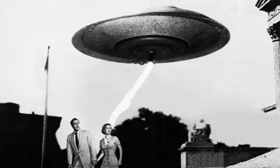
Flying saucers, also known as flying disks, have become synonymous with UFO's. Even the Encyclopedia Britannica interchanges the two terms. A UFO, however, is defined as "any perceived aerial phenomenon that cannot be immediately identified or explained."
While the term 'flying saucer' is slowly falling out of the modern American vernacular, they are still one and the same to a lot of people. Despite this stereotype, reports of disk-shaped objects make up a relatively small portion of reported UFO sightings.
Using data obtained from NUFORC and cleaned in the project UFO Reports I, I found that disk-shaped objects made up less than 4% of all reported UFO sightings in the 10-year period of 2010 through 2019. However, this wasn't always the case. In the 1970's and 1980's people reported seeing more disk-shaped objects than any other shape.
While there were more disk shaped objects reported in 2019 than there were in 1975, sighting reports of all shapes have increased. Therefore, while there may be more reported sightings of disk-shaped objects in our skies today than there were 40 years ago, the proportion of UFO sighting reports that are of flying saucers or disk-shaped objects has steadily decreased. While once the top reported UFO shape, the flying-saucer is now reported far less than other shapes.
Some things to consider as we go through this data:
The data used in this article is comprised of only the reported sightings maintained by NUFORC. There may be other organizations with sighting reports that haven't been incorporated into the NUFORC database. Therefore, there may be a selection bias as the data consists mostly of reports by people who reported their sightings directly to NUFORC.
Also, the reported shapes can be misleading. For example, depending on the angle, a disk can appear to be a circle or even cigar-shaped. One person's sphere is another person's circle. Likewise, a light isn't indicative of any shape at all. For this report, however, all shape descriptors are treated as distinct and unique shapes.
Finally, it is neither my goal nor my intention to debunk the UFO phenomenon. No matter what people believe regarding the UFO phenomenon, almost everyone can agree that most reports of UFOs have prosaic explanations and are natural phenomenon, man-made objects or celestial events that have simply been misidentified.
Disk Shaped Objects
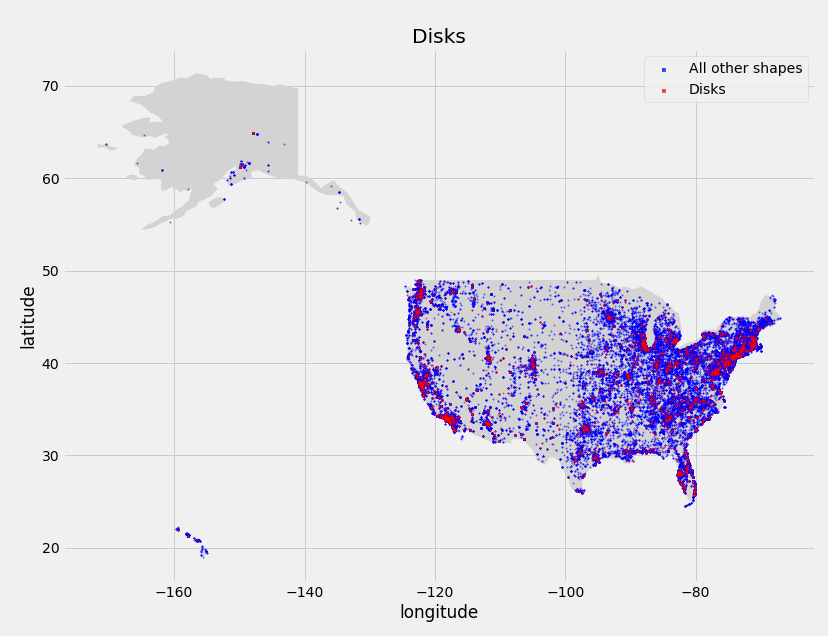
The Data:
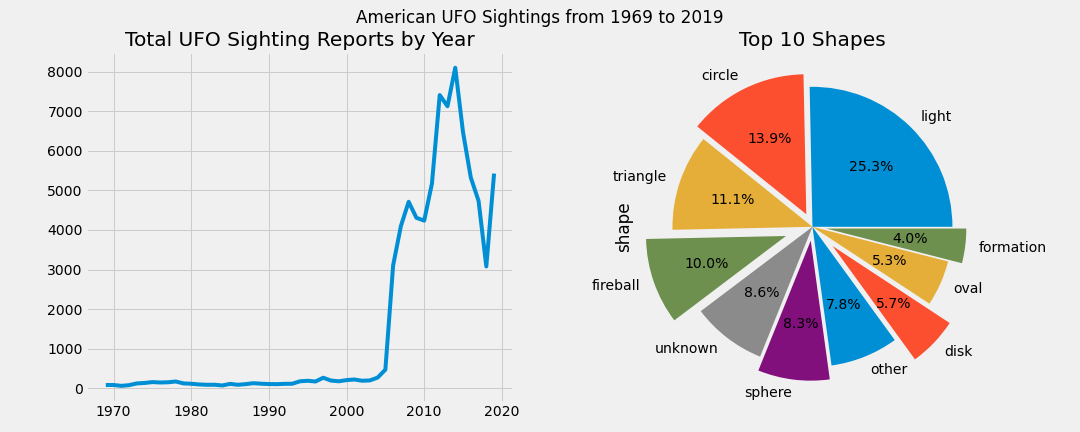
As we can see from Fig. 1, sighting reports remained steady until about 2006, where reports significantly increased. In that same year NUFORC moved their headquarters from Seattle to Spokane, so this increase in sighting reports is likely due to changes with NUFORC, such as a new website that made it easier for people to report their sightings.
If we separate the reports by the top shapes on the timeline for the years 2000 through 2019, we can see that there are fewer disks reported than the other top shapes.

While disk sighting reports did increase around 2006, they didn't increase nearly as much as the other top shapes. Lights, circles, triangles, spheres, and fireballs, are all reported more frequently from 2006 onward.
But what about prior to 2006? Let's zoom in on the years 1984 through 2000.
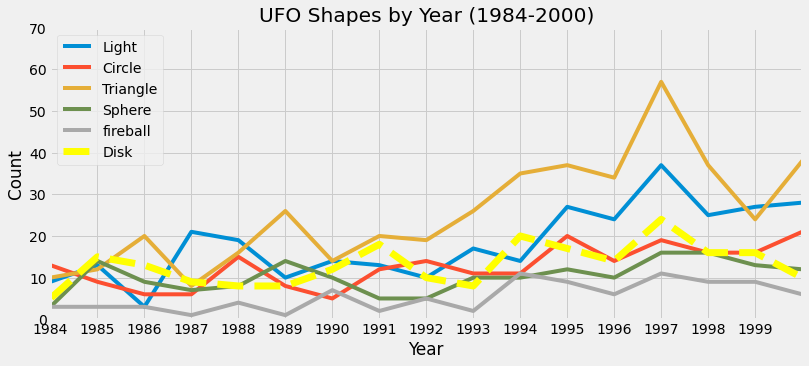
From fig. 3 we can see that reports of disks remained steady with the other top reported shapes. We can also see that reports of both triangles and lights start to increase in the 1990's. The increase in reports of lights make sense as we put more satellites in orbit and our skies become more crowded with aircraft. Likewise, the increase in reported triangles also makes sense, as the 1990's saw the military operating some interesting airframe designs such as the F-117 Nighthawk which was publicly revealed in 1990, and the B-2 Spirit, which entered service in 1997.
Let's go back on the timeline to the years 1969 through 1984.
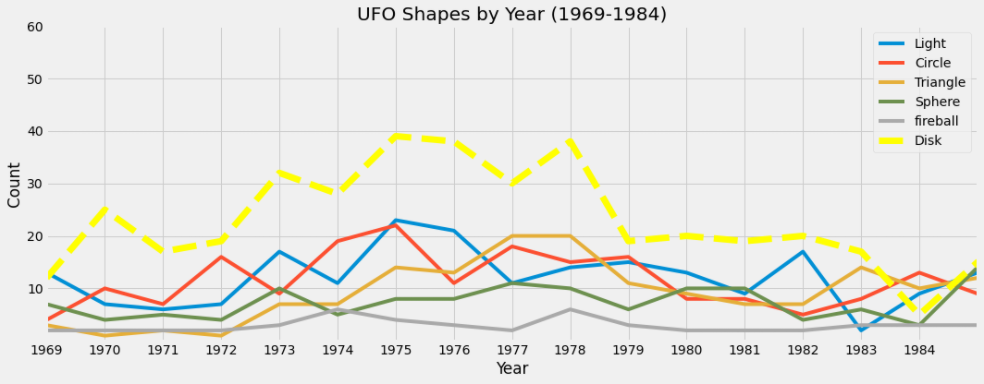
As we can see in Fig. 4, disks were the most frequently reported shapes until 1984. More people reported seeing disks than any other shape. According to the data, this was the era of flying saucers. This is likely when "flying saucer" became synonymous with "UFO" and the stereotype was born.
This trend can also be seen when looking at total sightings by decade and by year, as shown in Figures 5 and 6 below.

By Year:
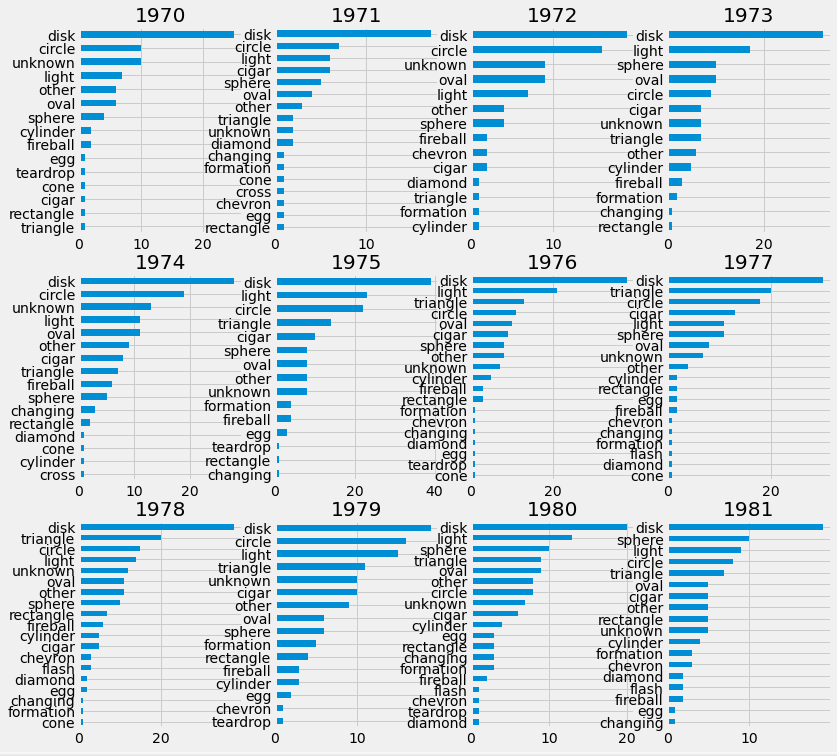
When looking at the total reported shape counts for the 1970's, 1980's, and 1990's in Fig. 5, we can see that disks were reported more than any other shape for the 70's and 80's. Looking at the total shape counts by year in Fig. 6, we see that people were consistently reporting more disks every single year throughout the 1970's.
So what does this look like over the decades as a proportion of overall sightings?

Disks went from being almost a quarter of all reported sightings in the 1970's to being less than 4% of reported sightings in the last decade.
Fig. 7 shows the slow and steady decline of disk sighting reports in proportion to the other reported shapes. In the 1970's, disks made up 23% of all UFO sighting reports for that decade. This slips to about 13% for the 1980's, then to just over 9% for the 1990's. The following decade sees disk sighting reports fall to 6% in the 2000's before falling again to 3.6% of all UFO sighting reports for the last decade.
Let's turn our attention to the timeline around 2006 where all sighting reports increased.
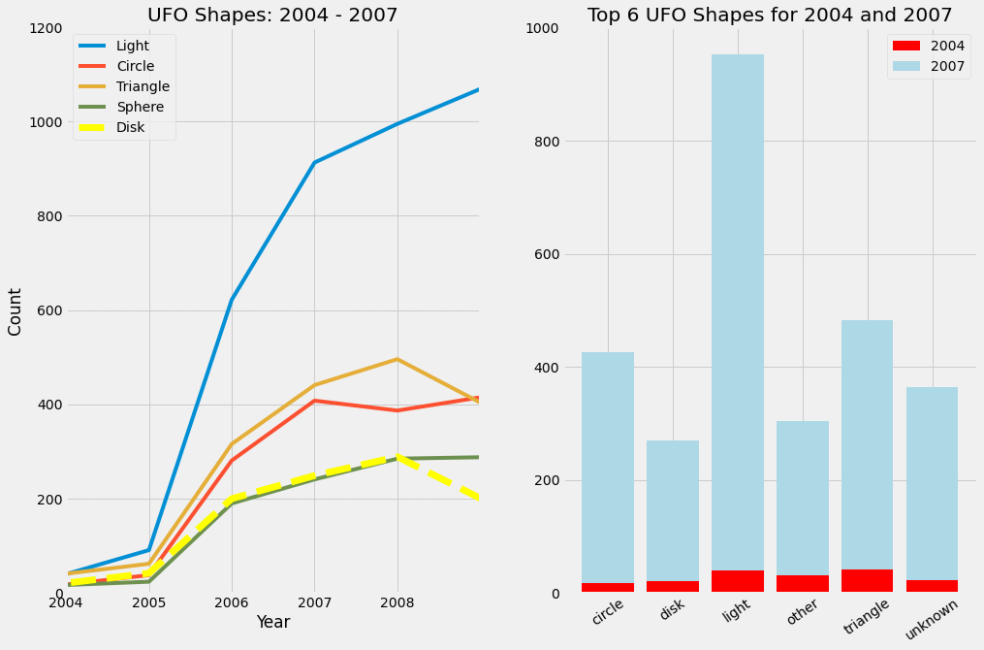
Fig. 8 shows the significant increase in sighting reports for the three-year span of 2004-2007.
We need to be very careful when talking about percentage increases of reports with this data because prior to 2006, each shape was reported a relatively small number of times compared to after 2006. Therefore, instead of calculating the percentage increase for each shape pre and post 2006, we'll subtract the overall proportions from the post-2006 proportions.

Fig. 9 shows that with the 2006 increase of all reported sightings, triangle and disk reports did not increase as much as the other top shapes.
Conclusion:
Flying saucers, or disk-shaped objects, once reported more than any other shape, now fall behind reports of lights, circles, triangles and other reported shapes. The 1970's were the heyday of flying saucer reports and likely the cause of the pop culture connection to UFO's in general. However, in proportion to all other shapes, reports of disk-shaped objects are waning with time.

Lights have become the most popular reported sightings in our modern era and this makes sense as there are more conventional aircraft in our skies, an increase of satellites in orbit, and the market is flooded with inexpensive drones. There are simply more lights in the sky to be misidentified or mistaken as unidentified.
As we saw in Fig. 3, in addition to an increase in reported sightings of lights, reports of triangles started to take off in the 1990's as well. This also makes sense. The 1990's saw more triangular and delta wing aircraft operated by the military, such as the F-117 Nighthawk and the B-2 Spirit, both of which can leave a lasting impression for unwitting onlookers. Likewise, it's probable that the United States military has new and still-classified airframes traversing the night skies.
Despite the stereotype of UFO's being synonymous with flying saucers that was clearly earned in the 1970's, disk-shaped objects are relatively rarely reported in our modern times.